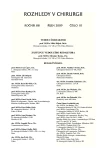Comparative Clinical Study Assessing C2 Dens Injuries Treatment Outcomes
Authors:
S. Kazda 1; J. Kočiš 1; P. Wendsche 1; J. Jarkovský 2
Authors‘ workplace:
Úrazová nemocnice v Brně, Klinika traumatologie LF MU Brno
1; Klinika biostatistiky a analýz LF MU Brno
2
Published in:
Rozhl. Chir., 2009, roč. 88, č. 10, s. 554-558.
Category:
Monothematic special - Original
Overview
The aim of this restrospective study was to compare treatment outcomes of C2 dens fractures following their conservative or surgical management, using direct osteosynthesis with canalised screws and the Dens Access device.
During 1999–2006, 108 patients with type II and type III dens injuries, based on the Anderson-D’Alonzo classification, were treated in the Brno Traumatology Hospital (Úrazová nemocnice Brno). Patients with type I injuries were excluded from the study. The study included 32 patients, who presented for a chek-up. Out of the total, 15 patients had undergone surgery, 17 had been managed conservatively. The mean age was 56 years (17–83 y.o.a.), 19 subjects were males and 13 subjects were females.
The conservative treatment included the following methods:
treatment with a Philadelphia collar (4 subjects) or a halo apparatus (13 subjects). Only patients, in whom at least a year elapsed since their injury, were included in the study.
The control group showed inferior results on ROM (range of motion), VAS (Visual analogue scale) and x-ray examinations.
Overall, in the conservative group, 3 subjects showed restricted cervical range of motion, compared to a single subject in the operated group.
The mean VAS was 3.
6 (0–7) in the conservative group, compared to the mean VAS of 2.9 (0–6) in the operated group.
No fragment displacements or development of a pseudojoint was recorded in the operated subjects. In the conservative group, fragment displacement was observed in 2 subjects. In the both subjects, the bone healed.
The Fisher’s exact test and the Mann-Whitney U-test were used for statistical analysis of the data.
Key words:
dens of C2 (axis) – dens axis – halo vest
Sources
1. Clark, Ch. R., White, A. A. Fractures of the Dens. A Multicentric Study. J. Bone Jt. Surg., 1985; 67-A: 1340–1347.
2. Suchomel, P., Taller, S., Lukáš, R., Froehlich, R. Chirurgické řešení zlomenin zubu čepovce. Rozhl. Chir., 2000; 79: 301–308.
3. Štulík, J., Suchomel, P., Lukáš, R., Chrobok, J., Klézl, Z., Taller, S., Krbec, M. Přímá osteosyntéza dentu – multicentrická studie. Acta chir. Orthop. et traum. Czechosl., 2002;69: 141–148.
4. Stroh, P. C., Bley, T. A., Ghanem, N., Scheck, B., Sudka, M. P., Muller, CH. A. Clinical and radiological findings after different traetment of odontoid fractures type Anderson II and III. Acta chir. Orthop. et traum. Czechosl., 2006; 73, 151–156.
5. Kočiš, J., Wendsche, P., Višňa, P., Mužík, V., Hart, R. Kompresní osteosyntéza dens axis instrumentariem Dens Access. Acta spondylologica, 2002; 1: 146–151.
6. Aebi, M., Etter, Ch., Coscia, M. Fractures of the Odontoid Process. Treatment with Anterior Screw Fixation. Spine, 1989; 14: 1065–1070.
7. Anderson, S., Rodrigues, M., Olerud, C. Odontoid Fractures: High Complication Rate Associated with Anterior Screw Fixation in the Elderly. Eur. Spine J., 2000;9: 56–60.
8. Apfelbaum, R. I., Lonser, R. R., Veres, R., Casey, A. Direct Anterior Screw Fixation for Recent and Remote Odontoid Fractures. J. Neurosurg., 2000; 93: 227–236.
9. Bednar, D. A., Parikh, J., Hummel, J. Management of Type II Odontoid Process Fractures in Geriatric Patients; A Prospective Study of Sequential Cohorts with Attention to Survivorship. J. Spinal Disorder, 1995; 8: 166–169.
10. Hanigan, W. C., Powell, F. C., Elwood, P. W., Henderson, J. P. Odontoid fractures in Elderly Patients. J. Neurosurg., 1993; 78: 32–35.
11. Howard, S. A. Cervical Spine Trauma. Spine, 1998; 23: 2713–2729.
12. Greene, K. A., Dickman, C. A., Marciano, R. F., Drabier, J. B., Hadley, M. N., Sonntag, V. K. H. Acute Axis Fracture: Analysis of Management and Outcome in 340 Consecutive Cases. Spine, 1997; 22: 1843–1852.
13. Wendsche, P. Verletzungen Der Wirbelsäule. 28. Jahrestagung Der Österreichischen Gesellschaft für Unfallchirurgie, Salzburg, 1992; 28: 116–117.
14. Anderson, L., D., D‘Alonzo, R. T. Fractures of the Odontoid Process of the Axis. J. Bone Jt. Surg., 1974; 56-A: 1663–1674.
15. Konstantinou, D., Levi, A. D. O., et al. Odontoid screw fixation. BNI Quarterly, 1997; 13: 14–19.
16. Geisler, F. H., Cheby, C., Poka, A., Brumback, R. J. Anterior Srew Fixation of Pesteriorly Displaced Typ II Odontoid Fractures. Neurosurgery, 1989; 25: 30–38.
17. Böhler, J. Anterior Stabilization for Acute Fractures and Non-Unions of the Dens. J. Bone Jt. Surg., 1982; 64-A: 18–27.
18. Jenkins, J. D., Coric, D., Branch, C. L. Jr. A Clinical Comparison of One and Two-Screw Odontoid Fixation. J. Neurosurg., 1998; 89: 366–370.
19. Subach, B. R., Morone, M. A., Haid, R. W. Jr., McLaughlin, M. R., Rodts, T. S., Comey, CH. Management of Acute Odontoid Fractures with Single-Srew Anterior Fixation. Neurosurgery, 45: 812–820, 1999.
20. Knöringer, P. International fixation of dens fractures by double-treated screws. Orthopedics and Traumatology, 1992; 1: 231–245.
21. Rainov, N. G., Heidecke, V., Berkert, W. Direct anterior fixation of odontoid fractures with a hollow screw spreading system. Acta Neurochir., 1996; 2: 146–153.
22. Schwend, R. K., Hennrikus, W. L., et al. Complications when using the cannulated 3.5mm screw system. Orthopedics, 1997; 3: 221 – 223.
23. Garfin, S. R., Botte, M. J., Waters, R. L., Nickel, D. L., Nickel, V. L. Complications in the Use of the Halo Fixation Device. J. Bone Jt. Surg., 1986; 68-A: 320–325.
Labels
Surgery Orthopaedics Trauma surgeryArticle was published in
Perspectives in Surgery

2009 Issue 10
Most read in this issue
- Spontaneous Pneumothorax – Management, Therapy
- The Current View of Surgical Treatment of Diverticular Disease
- Minimally Invasive Plate Osteosynthesis (MIPO) in the Humeral Diaphysis Fractures
- Treatment of Hernia Ventralis Permagna
